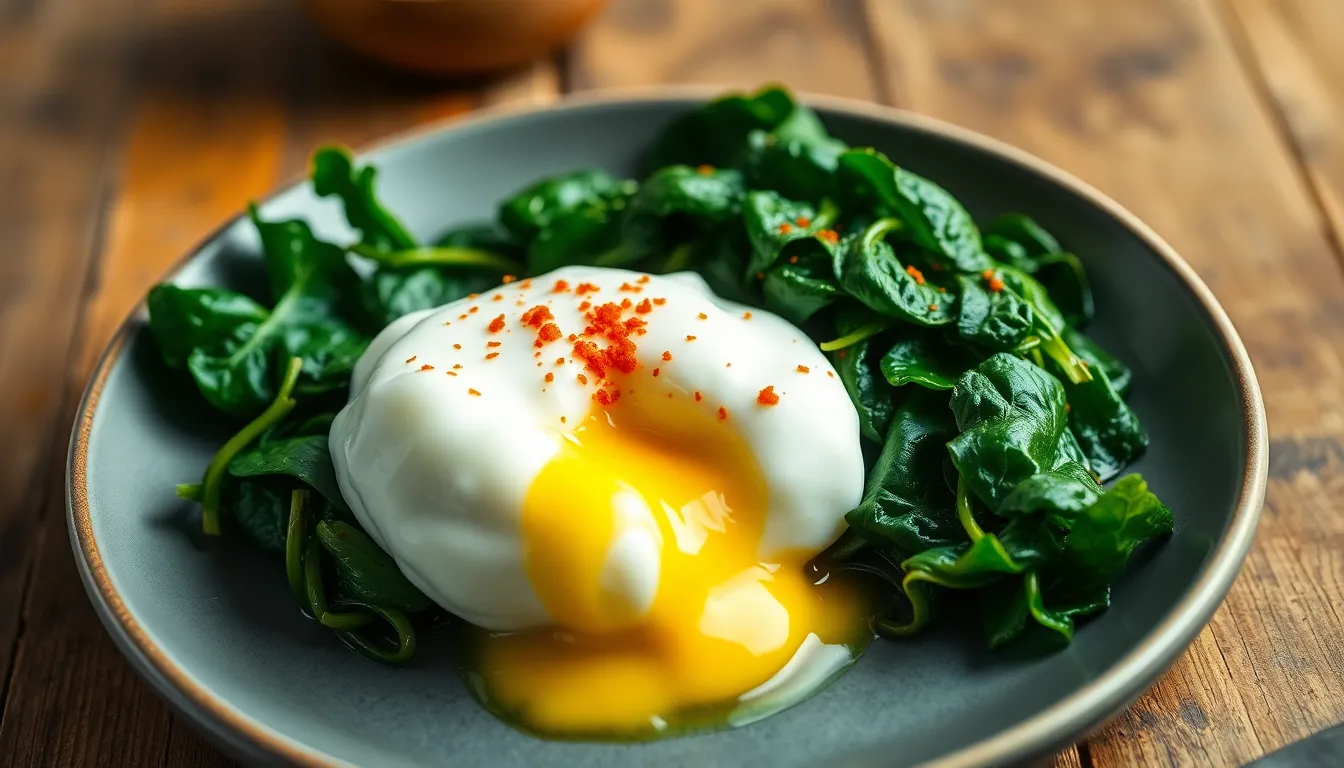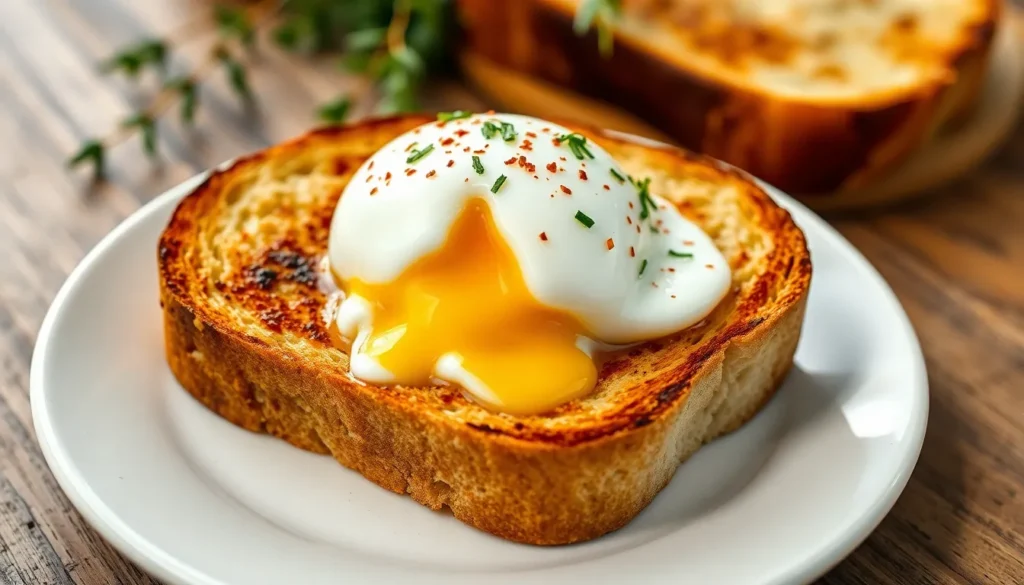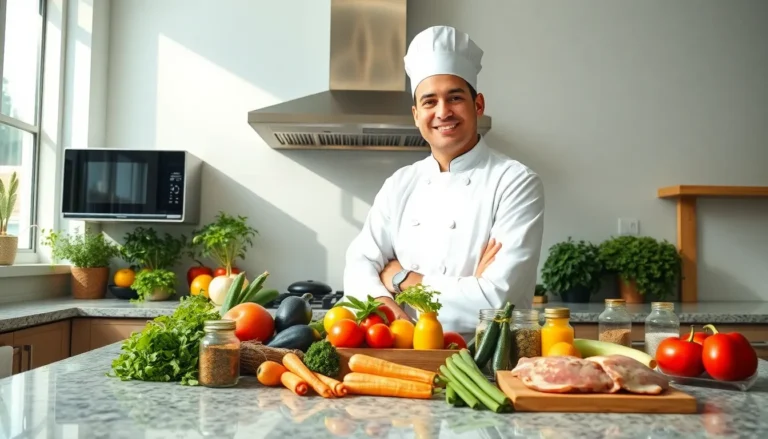Table of Contents
TogglePoaching eggs might sound like a culinary mystery wrapped in an enigma, but it’s easier than it looks—and way more fun! Picture this: perfectly cooked eggs, their creamy yolks ready to burst, transforming any meal into a gourmet experience. Whether it’s brunch with friends or a cozy dinner for one, poached eggs can elevate even the simplest dishes to new heights.
What Are Poached Eggs?
Poached eggs consist of eggs cooked outside their shells in simmering water. This method allows the egg whites to set while the yolk remains soft and runny. Cooking poached eggs requires careful temperature control, making this technique both simple and rewarding.
Typically, poached eggs are served atop various dishes, enhancing flavors and presentation. They pair well with items like toast, salads, or pasta. Chefs often recommend using fresh eggs, as fresher eggs maintain their shape better during cooking.
In preparing poached eggs, the water should simmer gently, avoiding vigorous boiling that can cause the eggs to break apart. A splash of vinegar in the water can also aid in coagulating the egg whites, resulting in a neater presentation. Timing plays a crucial role; usually, cooking for three to four minutes yields ideal softness in the yolk.
Garnishing poached eggs with herbs or spices elevates the dish. Common toppings include salt, pepper, or hollandaise sauce, enhancing flavor profiles. Many enjoy poached eggs for breakfast, brunch, or even dinner, highlighting their versatility in meal options.
Overall, poached eggs transform ordinary meals into culinary highlights. Their appealing texture and rich taste make them a favorite among food enthusiasts. Whether served as the main attraction or a complement to other foods, poached eggs remain a beloved staple in many kitchens.
Benefits Of Poaching Eggs

Poaching eggs offers numerous advantages in both nutritional content and health benefits.
Nutritional Value
Eggs, when poached, retain most of their nutrients. They provide high-quality protein, essential amino acids, and various vitamins. One large poached egg contains approximately 72 calories, 6 grams of protein, and significant amounts of vitamin B12, riboflavin, and selenium. Furthermore, the cooking method preserves the egg’s omega-3 fatty acids, promoting heart health. The low-fat cooking technique also avoids the addition of excess oils or fats, maintaining nutritional integrity.
Health Advantages
Poached eggs contribute to improved health outcomes. Their protein content supports muscle maintenance and repair, while vitamins and minerals support immune function. The healthy fats found in eggs enhance satiety and can aid in weight management. Nutrient density in poached eggs can also support cognitive function. Regularly incorporating poached eggs in meals may lower the risk of certain chronic diseases, further promoting overall well-being. With their numerous health benefits, poached eggs serve as a wholesome addition to any diet.
Techniques For Poaching Eggs
Poaching eggs offers various methods to achieve perfectly cooked results. Exploring these techniques helps anyone enhance their culinary skills.
Traditional Method
The traditional method involves simmering water in a deep saucepan. Adding a splash of vinegar promotes coagulation of the egg whites, resulting in a cleaner shape. Crack the fresh egg into a small bowl for ease. Gently slide the egg into the simmering water, ensuring minimal splashing. Maintaining a temperature around 180°F to 190°F allows the egg to cook evenly. Timing becomes critical; a period of three to four minutes ensures a runny yolk and firm white. Using a slotted spoon facilitates easy retrieval without breaking the egg.
Alternative Methods
Alternative methods provide creative approaches for poaching eggs. An immersion circulator offers precise temperature control for sous-vide poaching. Set the device to about 167°F for perfect results. Similarly, the microwave method allows for quick preparation. Place the egg in a microwave-safe bowl filled with water, covering it with a plate. Cooking for about one minute provides great results with minimal effort. Baking eggs in a water bath emerges as another innovative technique. Place eggs in a ramekin, surround them with simmering water, then bake for about 10 to 12 minutes for creamy yolks. Each method offers unique benefits, catering to different preferences and time constraints.
Tips For Perfectly Poached Eggs
Achieving perfectly poached eggs involves using the right equipment and avoiding common pitfalls.
Equipment Needed
Using specific equipment makes the poaching process easier. A deep saucepan serves as the main vessel for simmering water. A slotted spoon allows for easy removal of eggs once they are cooked. Fresh eggs contribute to better results, maintaining a compact shape. A thermometer can help monitor water temperature, ensuring it stays at a gentle simmer. Optional items like vinegar and a timer enhance the overall effectiveness of the process. Having all these tools on hand facilitates a smooth experience in creating poached eggs.
Common Mistakes To Avoid
Avoiding certain mistakes helps achieve a better outcome. Using water that’s too hot can lead to broken eggs and uneven cooking. Not adding vinegar may result in whites spreading too much in the water. Skipping the vinegar also affects the overall presentation. Cooking for too long turns the yolks firm instead of leaving them runny. Not using fresh eggs can lead to undesirable shapes and an unappealing appearance. Paying attention to these factors ensures successful poached eggs every time.
Mastering the art of poaching eggs opens up a world of culinary possibilities. With a few simple techniques and fresh ingredients, anyone can elevate their meals from ordinary to extraordinary. The versatility of poached eggs allows them to shine in various dishes, making them a favorite among home cooks and chefs alike.
By incorporating poached eggs into daily meals, individuals can enjoy their rich flavor and impressive nutritional benefits. Whether it’s a weekend brunch or a quick dinner, poached eggs provide a delightful experience that satisfies both the palate and the body. Embracing this cooking method not only enhances meals but also boosts culinary confidence in the kitchen.








